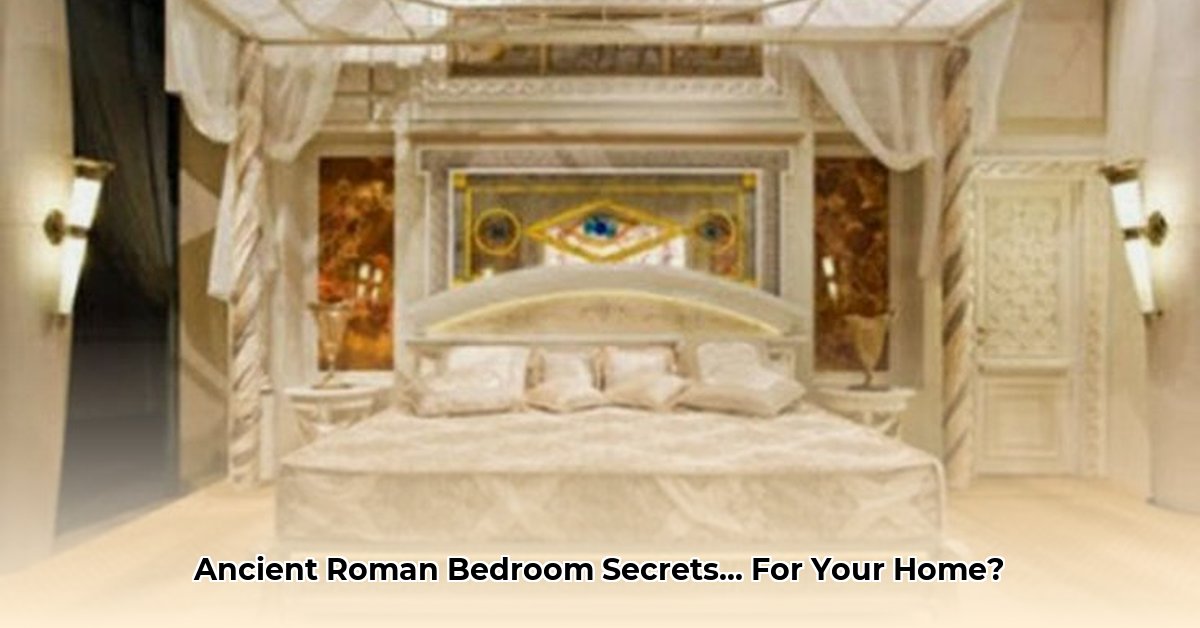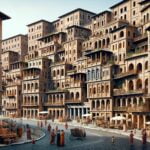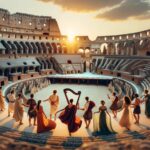Ever wondered what it was really like to live in ancient Rome? Learn about more ancient Roman artifacts. Beyond the grandeur of public forums and baths, lies the intimate sanctuary of the Roman cubiculum, or bedroom. Far from being a mere place for slumber, it was a multi-faceted inner sanctum, a testament to Roman ingenuity, their evolving sense of privacy, and the undeniable link between personal space and social standing. By peeling back the layers of these ancient chambers, we can uncover how they functioned, how they differed wildly from our modern sleeping quarters, and perhaps even unearth unexpected design inspiration for your own home.
The Cubiculum: A Private World of Many Functions
Dismiss the modern notion of a bedroom as solely a restful haven. The Roman cubiculum, deriving its name from “cubare” (to lie down), was remarkably versatile, a private retreat within the bustling domus (Roman house). Depending entirely on the needs and status of its owner, it could easily transform into a space for conducting business, proudly displaying prized possessions, or engaging in subdued religious practices. Think of it as ancient Rome’s answer to a home office, a personal gallery, and a private sanctuary, all rolled into one. Historical accounts, such as those from Varro, confirm its core sleeping function, while the writings of Pliny the Younger reveal cubicula that housed extensive libraries and even boasted sophisticated hypocaust (underfloor heating) systems for year-round comfort. Its naturally secluded nature also made it ideal for intimate gatherings, clandestine meetings, contemplation, and, in darker accounts, even served as a venue for murder or suicide.
The placement of these rooms varied within the domus. They typically led directly from the atrium, the central uncovered courtyard, and were often arranged to its right and left. In later periods, some cubicula were adjacent to the peristyle, an open colonnaded garden. Romans even distinguished between cubicula diurna, located in cooler parts of the peristyle for midday siestas, and cubicula nocturna or dormitoria, often positioned on the west side of the house to catch the morning sun. Many were small, often without direct windows to the outside, relying instead on weak oil lamps for illumination, which subtly highlighted wall decorations and mosaics. Some might have had small, high openings or grated windows for limited air circulation.
The Lectus: Centerpiece of Roman Comfort
The lectus, or bed, was undeniably the most important piece of furniture in the cubiculum, serving not only for sleep but also for reclining during meals, reading, writing, and receiving visitors. Its construction and comfort varied drastically with social standing.
For the elite, a lectus could be a lavish statement piece. These beds were often crafted from gleaming bronze or exotic woods like oak, maple, terebinth, and arbor vitae. Wealthy Romans adorned them with intricate carvings, and some even boasted inlays of tortoise-shell, ivory, silver, or gold, with legs sometimes fashioned from bronze or ivory. Imagine a lectus pavoninus, polished to emanate colors as rich as a peacock’s feathers. The most opulent examples, such as those mentioned by Petronius and Martial, could even be made of solid silver.
Mattresses (torus) were laid over crossed straps or thongs stretched across the wooden or bronze frames, acting as rudimentary springs. The filling varied significantly: poorer Romans used straw or reeds, while the affluent enjoyed padding of wool shorn from prized flocks, or even soft swan’s down. Archaeological finds, such as a mattress filled with leaves discovered in Herculaneum, suggest a practical, possibly anti-parasitic, approach. For added comfort, a bolster (culcita or cervical) was common. Beds were then covered with two layers: a base covering (stragulum) for resting upon, and an upper covering (operimentum) for warmth. A counterpane (lodix) or multicolored damask quilt (polymitum) would be placed on top, and a luxurious bedside mat (toral) often lay at the foot.
Beyond the common single bed (lectulus), Romans had double beds for married couples (lectus genialis). Dining rooms featured special couches designed to seat three people (triclinia), and for those seeking to impress, even larger couches accommodating six were known.
Beyond The Bed: Furnishings and Fixtures of the Cubiculum
While the lectus dominated the space, other essential furnishings contributed to the cubiculum‘s functionality.
Storage: Unlike modern bedrooms with ample closets, Romans relied primarily on chests (arcae) for storing clothing, linen, documents, and valuables. These were typically made of wood, often bound with iron and fitted with bronze hinges and locks. Smaller, precious arcae served as jewel cases, sometimes crafted from silver or gold. Large, heavy strong boxes, sometimes chained to the floor, were kept for ready money, emphasizing security over convenience. Cabinets (armaria) with doors, but notably without glass, were also used for storage, including protecting valuable books from pests.
Tables and Chairs: Roman tables (mensae) varied widely. The monopodium was a single-legged stand, often used in bedrooms for lamps or toiletries. The delphica had three legs, while the abacus featured a rectangular top with a raised rim, serving as a sideboard. The most costly tables, valued at astronomical sums (Cicero paid $20,000, and one family possessed one valued at $60,000), were round tables made from cross-sections of the citrus tree, prized for their beautifully marked wood. Chairs were generally sparse. Romans primarily used stools (sella) and benches (subsellia) without arms or backs. The sella curulis, a magistrate’s folding ivory chair, was a notable exception. More comfortable options included the solium, a stiff, high-backed chair reserved for formal occasions or deities, and the cathedra, an armless chair with a curved back, initially for women but later adopted more broadly. All were typically uncovered, relying on cushions and coverings for comfort.
Lighting and Timekeeping: Illumination came from simple oil lamps (lucernae) made of terracotta or bronze, often exquisitely designed, providing a dim, flickering light. Candles (candelae) made from tallow or wax, though known since the first century A.D., were considered inferior substitutes. Time was kept by sundials, even miniaturized pocket versions, but for indoor use, wealthy homes increasingly adopted sophisticated water-clocks (clepsydrae) from the time of Augustus.
Ancient “Refrigerators”: Surprisingly, archaeological evidence reveals early forms of cooling. Excavations at Novae, a Roman frontier fortress in Bulgaria, unearthed ceramic-tile food storage units, resembling small fridges, complete with animal bones and traces of cooked meat. Researchers like Piotr Dyczek, lead archaeologist, noted these discoveries are rare due to the fragility of such structures during building reconstructions. Similar shafts discovered at Roman Augusta Raurica in Switzerland are believed to have been used as cool stores, filled with snow and ice during winter and insulated with straw to preserve food well into summer, as demonstrated by Peter-Andrew Schwarz’s recreations.
A Tale of Two Comforts: Domus vs. Insulae Living
The opulent cubiculum offers a tantalizing glimpse into the lives of Rome’s upper crust. However, it’s crucial to acknowledge the stark contrast in living conditions for the vast majority. Poorer families resided in multi-story insulae (apartment buildings), often with a single room (cenaculum) functioning as a combined living, sleeping, and cooking area for an entire family. These rooms were sparsely furnished, lacking the privacy and lavish luxury of a cubiculum found in a grand domus. Water was fetched from public fountains, and the use of oil lamps and braziers in these wooden structures frequently led to fires.
This disparity compels reflection on the persistent socio-economic discrepancies that continue to shape urban living in today’s world. The concept of “comfort” in ancient Rome wasn’t solely about a soft mattress or a quiet night’s sleep; it was just as much about the ability to display affluence and deftly manage crucial social interactions within one’s most private quarters. While modern bedrooms prioritize rest, personal privacy, and individualized comfort, the Roman cubiculum was, in many ways, a stage for life itself, profoundly shaped by social standing and strategically adapted to serve a diverse array of needs.
Artistry and Atmosphere: Decorating the Roman Bedroom
The overall aesthetic of a Roman cubiculum was often far from stark minimalism. Walls, especially in patrician houses, burst with vibrant frescoes. These “masterpieces” often depicted natural landscapes, gardens, colonnades, fruits, or garlands of flowers, creating the illusion of greater space and bringing liveliness to the rooms. Trompe l’oeil effects simulating fake marbles were also common. The floors were frequently adorned with elaborate mosaics, adding another layer of intricate artistry with simple white tesserae or complex designs. The ceiling above the bed was often vaulted.
While comfort certainly mattered, the overt display of wealth through artistry and the use of costly materials often took precedence. The dim light from oil lamps would have subtly highlighted these masterpieces, creating an intimate, evocative atmosphere. However, it’s important to note the absence of certain modern conveniences: no mirrors hung on walls, no desks or writing tables as we know them, no dressers, no glass-doored cabinets for display. The grandeur of the domus structure and its integrated art often served as the imposing backdrop, allowing the furnishings to remain less dominant.
Timeless Lessons: Reimagining the Cubiculum in Modern Design
How can we channel the spirit of the ancient Roman cubiculum into contemporary homes? It’s not about literal replication, but rather borrowing key design principles that have transcended millennia, offering timeless elegance and functionality.
1. Embrace Multifunctionality: Like the versatile cubiculum, consider designing a “private space” that can adapt to various modern needs. Built-in storage solutions, adaptable furniture arrangements, and versatile lighting can support different activities, mirroring the flexibility of Roman private rooms. Can your bedroom serve as a quiet reading nook or a morning meditation space?
2. Prioritize Quality and Natural Materials: Opt for natural stone accents, solid wood furnishings, and handcrafted textiles like linen and wool. These choices echo Roman preferences for durable, authentic materials and contribute to a timeless, serene aesthetic. Concrete floors with a polished finish can even subtly mimic Roman plaster or flagstone.
3. Intelligent Lighting: Move beyond harsh overhead lighting. Employ soft, diffused illumination. Consider wall sconces, concealed LED strips, or dimmable lamps to create an ambient, layered glow, reminiscent of how oil lamps might have softly illuminated ancient cubicula.
4. Art and Purposeful Minimalism: While elaborate frescoes might be ambitious, a single, striking mosaic-inspired piece of art or a carefully chosen large-scale mural can powerfully evoke the Roman aesthetic without overwhelming the space. Embrace the Roman preference for uncluttered rooms; focus on essential, high-quality furniture pieces. “Less is more” was often the Roman way.
5. The Roman Color Palette: Begin with a neutral base—creamy whites, soft beiges, pale grays—for your walls and floors. Then, strategically add bold pops of color through soft furnishings, a single feature wall, or striking decorative objects. Cobalt blue, sunshine yellow, or a rich vermilion were favorites used in Pompeian frescoes and can make a sophisticated statement today.
6. Practicality and Personalization: The cubiculum was a profound reflection of its owner’s personality and status. So too should your modern interpretation be a unique reflection of you. Adapt these design principles to your own tastes and contemporary needs. Incorporate modern materials where appropriate, adjust the scale of architectural elements to suit your space, and tweak the level of ornamentation to fit your personal preferences. The essence is personalization and functionality – aim to capture that spirit, translating it into a space that truly works for you.
Bringing Cubiculum Style Home: A Modern Guide
| Design Aspect | Ancient Roman Cubiculum | Modern Interpretation |
|---|---|---|
| Bed (Lectus) | Wood (oak, maple, exotic woods), bronze frames; rope/thong support; mattresses of straw, reeds, wool, swan’s down, or leaves; covered with tapetia, stragulum, operimentum, lodix, polymitum. | Low-profile platform bed or minimalist frame; natural fiber mattress (latex, organic cotton); linen, organic cotton, or wool bedding; decorative throws or coverlets. |
| Wall Decoration | Vibrant frescoes (landscapes, mythological scenes, trompe l’oeil fake marbles); painted walls (often strong colors); integrated into the structure. | Textured paint (limewash, Venetian plaster); large-scale abstract or nature-inspired artwork; strategic use of murals or wall hangings that evoke classical themes or colors; minimalist art. |
| Flooring | Elaborate mosaic floors (white tesserae, geometric patterns, intricate designs); polished stone or marble floors; earthen floors for the very poor. | Polished concrete (mimicking Roman plaster); large format natural stone tiles; light-colored wood flooring; geometric patterned rugs in natural fibers like wool or jute. |
| Storage | Heavy wooden chests (arcae) with bronze/iron fittings for clothes, valuables; small safes; cabinets (armaria) for books or various objects. No modern closets. | Built-in wardrobes with flush doors; minimalist storage benches; decorative chests (vintage or modern) for blankets; woven baskets for soft storage; sleek, functional shelving. |
| Lighting | Dim oil lamps (lucernae) of terracotta/bronze; tallow/wax candles (* |
- Unlock ancient roman remedies: Natural treatments revealed for modern wellness. - August 17, 2025
- Unlock History: Ancient Roman Coin Necklace Trends & Buys - August 17, 2025
- Beyond Gladiators: Achievements in Ancient Rome Still Shaping Our World - August 17, 2025
















